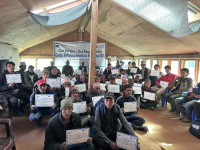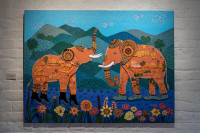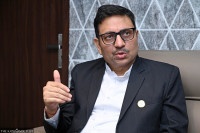Culture & Lifestyle
Upcoming Nepali artists and designers put on first exhibition
This year’s iteration of Kathmandu University’s BFA exhibition showcases art and its heterogeneity..JPG&w=900&height=601)
Asmita Manandhar
At Nepal Art Council’s ground floor exhibition space, a group of people are huddled over a small table attempting to play a board game titled Space Mess. An instruction manual is placed on a nearby table, in front of a huge wall painting and a few posters of the game. The creator Amogh Parajuli is encouraging people to try their hand at the game.
Parajuli is one of 16 graduates from Kathmandu University Department of Art and Design’s 2019 batch—whose final year projects are being displayed in a joint exhibition titled ‘Belonging’. From board games, comic strips, children’s books with illustrations, an installation on meditation to acrylic and oil-based paintings on salvaged wood from an artist’s home, wrecked by 2015 earthquake, the exhibition presents a variety of art forms.
This broad range of art and design successfully showcases the artists’ and creators’ individuality with particular emphasis on their skills and interests. It pays testament to how the art school has been providing space to its students to explore diverse issues and concepts, as well as giving them the liberty to follow their own artistic paths into their own personal interests.
One of the exhibition’s recurring and interesting themes was the availability and accessibility to the documentation of the entire process. This gives the audience a peek into the artists’ inspirations, through mood boards, initial ideas and even alterations to their designs and artworks, laying bare the failures they went through before coming up with their final products.
It is a challenge to showcase 16 artists’ pieces, and more challenging to maintain continuity to hold the audiences’ attention while they move from one exhibit to another. But each exhibit occupies its own space with the apt use of wall paintings, posters, installations and multimedia—each holding its own personality.
For instance, a graphic novel titled Fools Anthology Vol 1 by Sudim Raj Bajracharya has a collage of its comic strip plastered on the wall, quickly drawing attention to the book. It is similar to other illustrative works, such as Bhunti’s Trip by Subicha Gurung and Finding Myself in Paris by Subha Joshi. Moreover, Brix—a card battle, a game created by Kemesh Maharjan, even displays its trailer with instructions on a television screen.
.JPG)
Amid the modern forms of artworks and designs, Hitesh Vaidya’s exhibit, separated through muted grey walls on all sides, titled ‘Recollecting Memories’, is fresh and different from the rest of the exhibition. The artist has repurposed scraps of wood and paving stones scavenged from his home destroyed during the 2015 earthquake. These salvaged objects as his canvas, which Vaidya fills with nostalgia and memory. His meticulous efforts—not just in his paint but his endeavour in saving the originality of his medium—is commendable. With his simple yet detailed art, which imbues an old-world feel, he describes his personal recollection of a space he once called home.
Showcased right next to Vaidya’s exhibit, Tashi Lama’s ‘Woven Dreams’ also follows a personal journey, but of the artist’s mother and her hardships. Through the installation of his workspace—which he says he could achieve because his mother weaved carpets to make ends meet and in turn helped Lama weave his dreams. Albeit a strong concept, his installation seemed restricted.
There were similar limitations with other exhibits like Pooja Duwal’s ‘Everyday Aesthetics’ and Riya Dhungel’s ‘Wander-lost in Paris’. While Duwal’s oil on plyboard consists of interesting everyday objects and places, it was mundane and doesn’t offer anything new; Dhungel’s photographs of Paris, one of the most popular cities in the world, comes across as a hackneyed attempt.
.JPG)
On the other hand, Allen Tuladhar’s product ‘Alevate’, a flexible and portable table displays the creator’s vision on creating simplistic yet a practical solution. His execution is as clean as his idea to build space-friendly furniture fit into small spaces and for all age groups.
The joint exhibition is nothing extraordinary, but the artists’ attempts to expand their own experiences into diverse forms of art and design is praiseworthy. One common thread in all 16 exhibits is an observant and honest depiction of the artists’ perspective. According to Sujan Chitrakar, head of Department of Art and Design, the exhibition “meaningfully weaves the artists’ collective efforts into a thematic thread of belongingness”. Hence, the exhibition’s title: ‘Belonging’.
The graduating artists have shown where they have settled and have chosen where to belong within the vast spectrum of art—and this is just their beginning.
Belonging will be on display until July 24 at Nepal Art Council, Babarmahal, Kathmandu.
***
What do you think?
Dear reader, we’d like to hear from you. We regularly publish letters to the editor on contemporary issues or direct responses to something the Post has recently published. Please send your letters to [email protected] with "Letter to the Editor" in the subject line. Please include your name, location, and a contact address so one of our editors can reach out to you.




 8.12°C Kathmandu
8.12°C Kathmandu.jpg)















